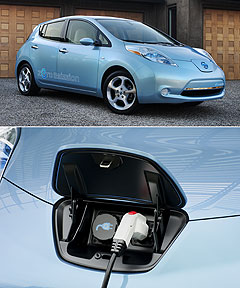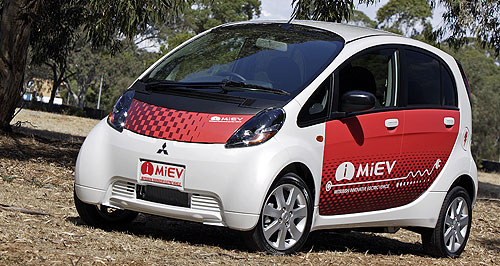Make / Model Search
News - General News - Electric VehiclesSmall EVs cost competitive, NSW study findsFuel saver: The Mitsubishi i-MiEV electric car will be one of the first battery-powered cars on the Australian market. Fuel savings make plug-in electric cars a match for petrol cars over their lifetime1 Feb 2010 SMALL electric vehicles (EVs) destined for the Australian market within two years will be cost competitive with similar-sized fossil-fuelled cars over the lifespan of the vehicles, an independent study commissioned by the New South Wales government’s EV Task Force has found. The analysis by the Australian branch of international consultancy AECOM found that savings on fuel and maintenance costs over time would defray the initial higher purchase cost of the vehicle on a cents-per-kilometre cost basis – and get even more favourable as EVs get cheaper and oil prices rise over the next three decades. As well, such vehicles would provide immediate savings in greenhouse gas and air pollution emissions, with consequent savings for the public purse. The report drew partly on research data from Curtin University, whose senior research fellow, Dr Andrew Simpson, was a technical advisor to the study team. The automotive industry is set to launch 30 new EVs and plug-in hybrid vehicles (PHEVs) in the next three-to-five years, with such cars available to Australian motorists by 2012, says the report, which was delivered to the NSW environment and climate change department in September last year and now released online. AECOM estimated the current lifetime cost of a small plug-in “pure” EV – such as Mitsubishi’s forthcoming i-MiEV or Nissan Leaf – to be about 26 cents a kilometre, compared with a similar-sized internal combustion engine (ICE) car at 26.3 cents a kilometre.  Left: Nissan Leaf. Left: Nissan Leaf.By 2040, the EV cost would be down to 19.1 cents a kilometre, while the ICE small-car cost would remain static at 26.4 cents. Larger vehicles, however, are expected to take longer to reach the break-even point, partly because only high-end large EVs are set to be launched initially. A large electric-powered vehicle’s current whole-of-life cost would be 41.6 cents a kilometre, compared with a similar conventional large car’s 35.2 cents a kilometre. By about 2030, however, large EVs should break even, and by 2040 be significantly cheaper at 24.3 cents a kilometre compared with the ICE car cost of 35.5 cents. The investigation was commissioned to assess the economic viability of plug-in EVs and to identify any net benefit to society. For the purposes of simplicity, it was restricted to the Sydney metropolitan region. It required AECOM to develop complex economic modelling based on a number of assumptions, including future energy cost rises and potential roll out of various vehicles types, from hybrid electric vehicles (HEVs) over the over the next five years, to plug-in hybrid electric vehicle (PHEVS) over the medium term (5-20 years) and full EVs (20-plus years). Dr Simpson told GoAuto that he believed the research could be widely applicable to other parts of Australia and that other states had already shown an interest in it as they formulated policies for future road transport needs. The report estimated the current cost of automotive lithium-ion batteries to be at least $10,000 – the main cost premium of EVs over conventional cars – but concluded that battery costs would decline through “industry learning curves” and improved economies of scale. It also predicted continuing advances in battery performance, vehicle range and useful life, as well as more widely available charging infrastructure, helping to drive up popularity of EVs and PHEVS. The study looked at vehicles of various sizes and types – including commercial vehicles and taxis – as well a variety of distances travelled per year under number of scenarios. The study assumed that the oil price would rise from $US74 ($A84) a barrel this year to $US80 ($A90.7) a barrel in 2040 – a view than many people in the motor industry would regard as extremely conservative. The model assumed that electricity prices would also rise, to 20 cents per KWh by 2040. While the study found that small plug-in EVs would be immediately competitive, it also found that ownership costs of petrol-electric hybrids and the new-generation plug-in hybrids – a group that will include General Motor’s Volt – were not currently cost competitive with standard cars. It found that medium-sized hybrid cars were about 10 per cent more expensive over their lifetime than conventional cars. A pure EV was the most cost effective, due to greater savings in day-to-day fuel costs. However, like EVs, the hybrids would be more cost-effective over time as their fuel savings limited the impact on the wallet of rising fuel costs. By 2040, the study estimates, a medium-sized PHEV would cost 22.7 cents a kilometre over its lifespan, compared with an HEV’s 27.2 cents and ICE vehicle at 28.7 cents. An EV would still be the best at 19.9 cents a kilometre. The study cautioned that a number of issues need to be considered, including uncertainty about battery life, infrastructure set-up and potential global supply constraints for EVs and hybrids. AECOM concluded that the plug-in EV market in NSW was “both economically and financially viable”. “However, the economic and financial returns accrue over the longer term,” it said. “The move towards a plug-in electric vehicle market also generates large savings in greenhouse gas and air pollution emissions.” The study found that there would be an increased uptake of alternative engine configurations in small vehicles. “Significantly, despite the high vehicle price, small EVs are around the same lifetime cost per kilometre as ICE vehicles in 2010 due to large fuel cost savings over the lifetime of the vehicle. “As vehicle prices fall, the vehicle range increases and more charging infrastructure becomes available, owners of larger vehicles and vehicles that travel large distances tend to purchase a higher proportion of EVs. “This is due to the fact that operating costs are more important for these vehicle owners.” The report said the removal of supply constraints and provision of charging infrastructure were key areas that warranted further attention if EV take-up was to be encouraged.
Source: AECOM  |
Click to shareGeneral News articlesResearch General News Motor industry news |
||||||||||||||||||||||||||||||||||||||||||||||||||||||||||||||||||||||||||||||||||||||









Facebook Twitter Instagram